A 1:20 scale
live steam donkey

A steam donkey is a specialized type of winch used mainly in logging operations in the USA starting in the late 19th century.
The models we are building do not follow a particular prototype, they are designed to be operated while still retaining a scale look.
We have four models: three "production" models and one prototype.
You can see some recent pictures of the machines in the gallery.
Here are some drawings of the various parts as well as a bill of material:
This is a 3D pdf of the complete donkey. You will need Acrobat reader version 7.0 or newer to view this file. You may need to click under the title to make the 3D model appear. Once loaded, you can rotate and zoom it. Change the view to transparent to see the internal structure of the boiler.
The rest of the page shows the early stages of development way back in 2003!
We eventually plan to build several donkeys in order to reproduce a complete logging operation. We are currently (march 2003) working on the prototype.
We are planing on using custom cast metal parts for the bearing supports in the "final" models. Click on the pictures to see an high resolution version:
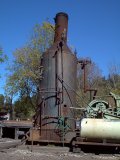
|
This is a picture of a real donkey boiler. This donkey can be seen at Roaring Camp in Felton, California. |
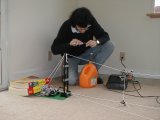 |
When we first started talking about a working 1:20 scale donkey, we didn't know if it could be done. Simple things like pulley friction and rigging setups had to be prototyped.
So I built this Lego donkey to test the basic concept. |
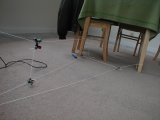 |
Here, you can see the far end of a "south bend" rigging, using table legs as spar trees. |
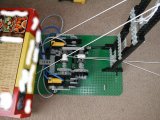 |
Here is a close up on the "steam engine": it is actually run by two pneumatic pistons. |
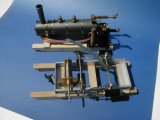 |
We first built the basic frame and quickly added the first spool to check if our choice of gearing was correct. Steam was provided by an Accucraft Ruby boiler mounted on skids. |
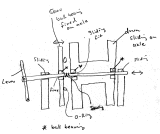 |
We then used our high powered CAD system (NapkinCAD) to design a clutch. The spools are mounted on miniature ball bearings. An o-ring sqeezed between the brass gear and PVC spool face provide the friction for the clutch. |
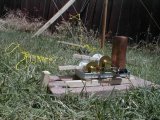 |
Here is a view of the donkey after completion of the two spools with clutches. The spools are made from PVC pipes with their sides made of large diameter PVC pipe endcaps.
The brakes are not yet installed, so cloth pins are used instead. |
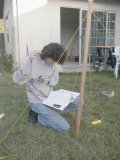 |
This is our first attempt at using the donkey. Rigging is done "by the book". |
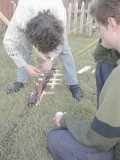 |
Here I'm doing some last minute adjustments while Eric looks on. |
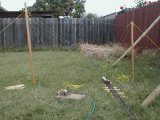 |
After trying other types of rigging, we found out that the so called "crotch line" loading arrangement was best suited at this scale. |
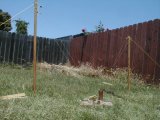 |
Crotch line rigging is easy to setup and has very low friction while operating. |
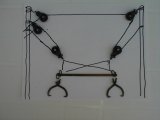 |
This picture shows a crotch line rigging arrangment. The sheaves we use are comercial cast metal items with home made brass pulleys and steel axle. This construction provides reliable operation while keeping a nice, scale, look. |
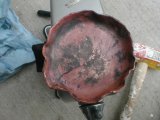 |
The next main step was to build a boiler. This picture shows a piece of copper in the midle of beeing formed to make one of the end caps of the boiler. |
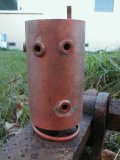 |
Here is the finished boiler. It is made from a section of 2" diameter pipe. |
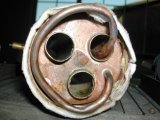 |
This is a view from the bottom of the boiler. The three flues are clearly visible. The small pipe exiting the boiler and looping around before going through one of the flues is the main steam line to the cylinders. This arrangement is a basic super-heater. |
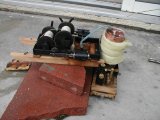 |
The boiler was tested by mounting it onto my Vermod locomotive. |
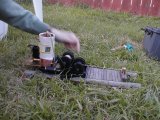 |
The first "real" test came once we had a proper sled (made by Eric): would the donkey be powerfull enough to move itself? |
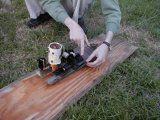 |
Well, it could not make it in the grass but managed to pull itself on this piece of plywood. |
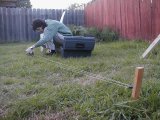 |
Here is a view of the complete setup with the three part line. |
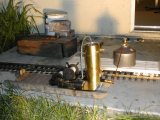 |
During the previous test, the boiler was fired by a burner borrowed from the Vermod. During this test we used a ceramic burner (built in the UK by Cheddar.): the results were impressive! |
 |
Our sled is a bit too short to accomodate the fuel tank. This is not a problem when the donkey is used for actual loading and yarding: the tank will be disguised as a wooden water tank. For the moving test we had to be creative... Note the almost complete Carter brother flat car (built by Henner from a Hartford kit). |
| Here is a short movie (4MB in size) of this latest test. | |
